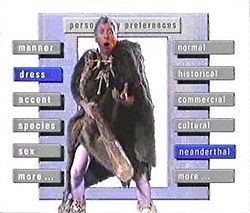Genre Technology Country of origin United Kingdom No. of series 1 Initial release 1990 Number of episodes 1 | Original language(s) English No. of episodes 1 First episode date 1990 Screenplay Douglas Adams | |
 | ||
Cast Similar The Passionate Pilgrim, The Zany Adventures of Robin, The Hitchhiker's Guide to t, The Curse of King Tut's Tomb, The Five Doctors | ||
Hyperland hiperlandia documental por douglas adams 1990
Hyperland is a 50-minute-long documentary film about hypertext and surrounding technologies. It was written by Douglas Adams and produced and directed by Max Whitby for BBC Two in 1990. It stars Douglas Adams as a computer user and Tom Baker, with whom Adams had already worked on Doctor Who, as a personification of a software agent.
Contents
In hindsight, what Hyperland describes and predicts is an approximation of today's World Wide Web.
Content
The self-proclaimed "fantasy documentary" begins with Adams asleep by the fireside with his television still on. In a dream that follows, Adams, fed up by game shows and generally passive, non-interactive linear content, takes his TV to a rubbish dump, where he meets Tom, played by Tom Baker. Tom is a software agent, who shows him the future of TV: interactive multimedia.
Much like Apple Inc's Knowledge Navigator concept, Tom acts as a butler within a virtual space populated with hypermedia: linked text, sound, pictures and movies represented by animated icons. The documentary is centred on Adams browsing these media and discovering their interconnectedness.
This process leads him, for example, from the topic Atlantic Ocean to literature about the sea to The Rime of the Ancient Mariner by Samuel Taylor Coleridge to the poem Kubla Khan by the same author to Xanadu and back to the topic of hypertext via Ted Nelson's Project Xanadu. The references to Coleridge and to Kubla Khan are rather knowing nods to Adams' own book Dirk Gently's Holistic Detective Agency, where they play significant roles in the plot. Dirk Gently was published in 1987 and also touches on the themes of interconnectedness, suggesting that this was a subject Adams had thought about at some length and some time.
Many aspects of the documentary demonstrate Adams' noted enthusiasm for technology, and for Apple computers in particular. At the beginning of the documentary a Macintosh Portable can be seen, and most of the projects presented run on Apple hardware. Even the general design of the animated icons and environments featured in his dream are inspired by pre-OS X era Mac OS icons and design cues.
Multimedia
While Adams is browsing, many people and projects related to the general theme of hypertext and multimedia are presented:
The dream (and the documentary) ends with a vision of how information might be accessed in 2005. In hindsight, Hyperland does describe a number of features of the modern web and, apart from some underestimates of graphics and processing power available, the documentary paints a not inaccurate picture of hypermedia and hypertext and how they are used today. This is especially noteworthy considering that it predates the public release of the first Web browser by about a year.
